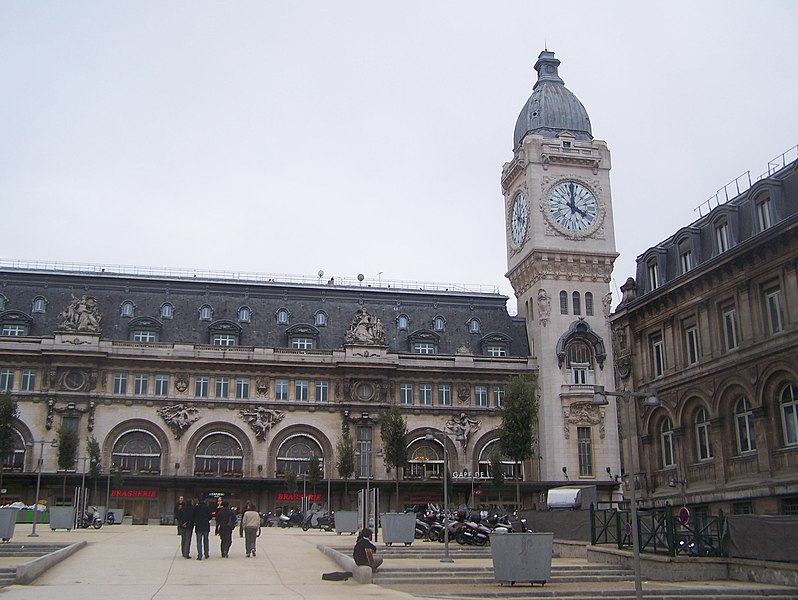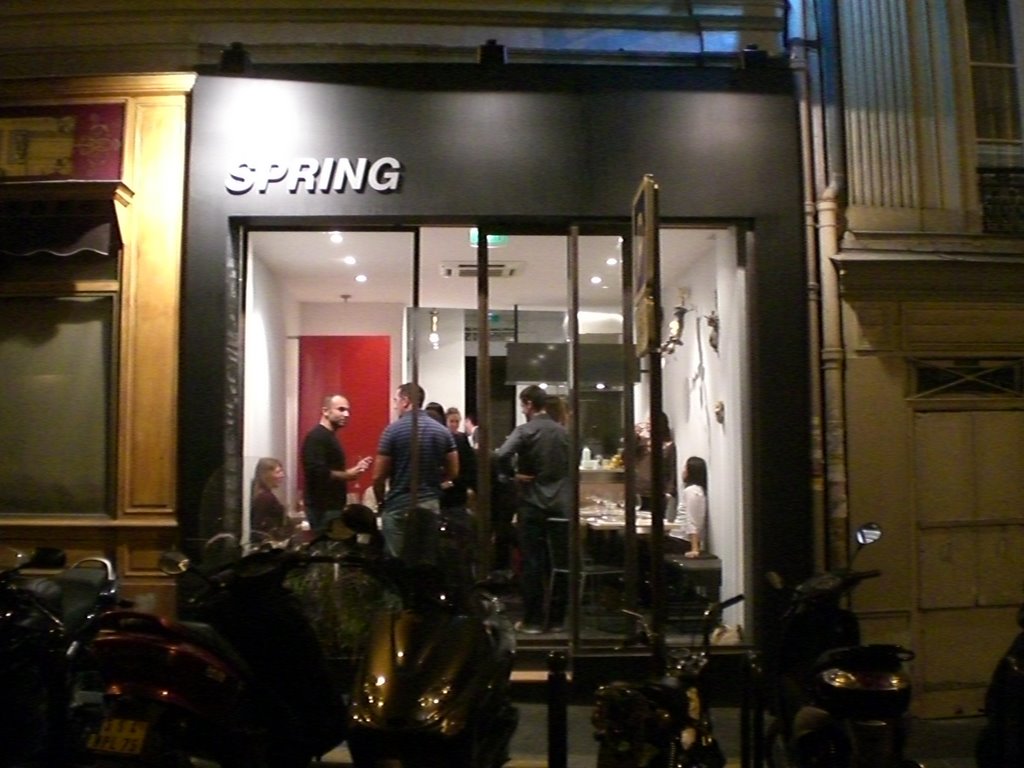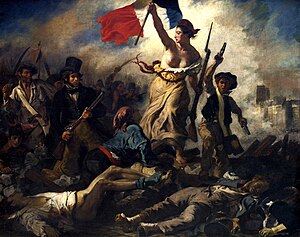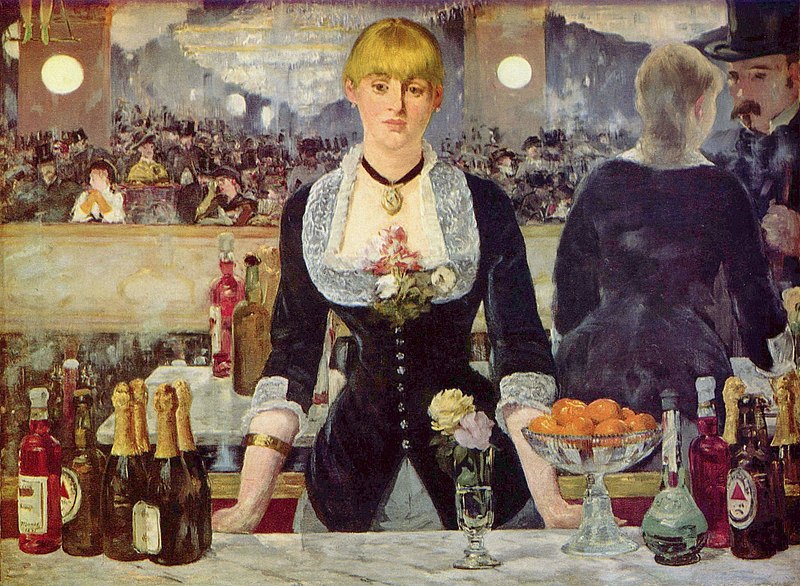
April 29. Ah, the day I have looked forward to the most finally arrived. It was drizzling out and the shops did not open until 10 a.m. so we had a leisurely morning getting ready, watched CNN

to see what was happening in the rest of the world (not that we actually cared), ate breakfast at the corner bakery and headed to our secret, free Metro entrance. The trip only took about 10 minutes, we made one transfer and ended up the Anvers stop at the base of Montmartre. Leaving the Metro, I found us on Boulevard de Rochechouart (a major street) and Rue De Steinkerque (a side street loaded with fabric shops). Sacre Coeur was at the top of the street. We needed our umbrellas, but the rain was light. First I just wanted to take it all in, looking, but not actually entering any shops. This was not a problem since most shops displayed some actual fabrics outside. Most shops had awnings which protected the fabrics, so the merchandise did not get wet. We reached the end of Rue de Steinkerque and turned right on Place Saint Pierre. That was where Reine and Marche Saint Pierre are both located and now I was ready to do some actual shopping.
We first went into
Reine. This is one of the larger stores having four floors of fabric. The first floor has mostly women's garment fabrics. All the fabrics were on rolls laid out on tables according the fabric type, mostly rayon, silk, cotton, linen--seasonal fabrics. The prices are clearly marked and most tables also have a mannequin about a meter tall with a garment made from one of the fabrics on the tables. I did not take a picture, but wish I had. These mannequins all wore wigs that really did not suit them, but were straight hair with bangs covering their eyes. The sample garments were interesting, but I did not look on the inside to see how they were made. I did see very nice fabric and the prices were certainly more reasonable than at Bouchara, but there really wasn't anything I had to own. We ventured up to the second floor (or the 1st floor in Europe) taking the stairs since the elevator was no where to be seen. Up there were wools, some notions and decorator fabrics. Still nothing I had to own and no mannequins beyond the ground floor. Up to the next floor, more decorator fabrics and all the trimmings to go with them. Then up the stairs to the top floor. More decorator fabrics, but here is where the toiles were located. I actually expected a larger selection than was there, but the quality was excellent, and if I remember correctly, around 20 Euros a meter. If I were making drapes, this is where I would go. Well I did not score at Reine, but I would go back. I guess I just was not in the mindset for what was offered that day. I may also have gone back to look again had I not purchased any fabric later in the day.
Next stop was
Marche Saint Pierre which was perpendicular to Reine. Another large fabric shop. The first floor again contained fabrics which were in season, dressy fabrics, cottons, velvets and everything was on rolls. Still nothing called my name. Up to the second floor and linens for the house. You certainly could use some of these for clothing. The next floor was primarily clothing fabrics, wools, silks, jerseys, lace and linings. Still nothing caught my eye. Up to the next floor--decorator fabrics and the next floor up had the really expensive decorator fabrics along with the decorators themselves. My stash was very much under control so far. Back down the stairs and on to the street.

Just across from Marche Saint Pierre, near Reine was a little shop called Le Coupons de Saint Pierre. This shop had all pre-cut fabrics in 3 meter lengths in a variety of fabrics. Some were not worth looking at, but there were treasures in the mix with lots of natural fabrics. The fabrics were arranged by fabric type and each had a tag on it identifying the fiber content, length and cost. I had brought
all of my swatches from my stash, but I was trying to match a certain few. Voila, I found a great match in a 120 brown and grey wool stripe with more than enough for a pair of pants and possibly a skirt or vest. It wasn't all that cheap, but it wasn't overpriced either. The owner of the shop looked like she was around my age and was very cordial to me even though she did not speak English and my French is horrible. Credit cards say it all, anyway. If you happen to be looking for something specific, this may not be the place to go, but there certain was a variety to choose from.
Moving further down the street I found the next "coupons" store, Au Gentleman des Tissus (the Fabric Guy?) with "sacres coupons". Lots of the stores had the word "coupons" in their title, which means pre-cut lengths of fabric and all coupons I found to be in 3 meter lengths. I never

asked if a length could be cut, but I am assuming they could not since all of them appeared to be the same length. This store was a little larger than the previous, but all cuts were again arranged by fiber and neatly placed on tables with the cuts overlapping each other so you could see all the merchandise. Touching the fabrics was not a problem in this shop and I found one that felt lovely, a blend of black and cream wool & silk in a small herringbone weave. This would be perfect to replace my black, grey and cream wool tweed jacket that I have worn out. The price for this gem was 30 Euros (10/meter). Not a steal, but a good buy. The owner did not speak English that well, but she did speak German, so Ken was able to converse with her. She said that the "sacres coupons" was meant to be a joke since they were located at the foot of Sacre Coeur and their fabric was "sacred".
Across the street and along that block was Moline which was a group of storefronts specializing in decorator fabrics. If they had a shop with just garment fabrics, I couldn't find it. There were lovely silks, linens, cottons, all for upholstery or drapes and all the extras that go with them.

However, on the same side as Sacres Coupons, was the Moline notions shop. This store carried a variety of tassels, cording, etc for decorating, but also had the necessary notions for dressmaking. There was a lovely selection of buttons in all colors, zippers, threads, elastics, all types of trim and a large selection of ribbons, appliqués, and embellishments. There also were books and magazines, but most of them were for knitting or embroidery. Off the main room was a smaller room which had quilting fabrics, but they appeared to be the same as what was found back in the States. I spent a long time looking at buttons and was able to match some metal

buttons to a boucle from my stash which is an unusual color brown. I was a happy camper.
Now I was on a roll. We walked to the end of Rue d'Orsel, turned around then walked back so I could investigate the smaller streets which we hadn't seen yet. We ended back where we originally started on Rue de Steinkerque. Now that I had a better sense of the area, this time I spotted some fabrics outside of one of the shops and started fondling them. A gentleman came out

of the shop and started speaking to me in English asking me to come in, which of course, I did. He had a great selection of fabrics, lots of 120 wools, silks, linen and cotton. I noticed a staircase to the side and asked if I could go up. Sure enough all the out of season wools were there and a large selection of tweeds and boucles. An older gentleman, whom I am assuming was the father of the gentlemen who invited us in, was in charge upstairs. The older man did not speak English, but sure knew how to sell

fabric. He tried to figure out what I was looking for even though I really did not know myself. He kept pulling out fabrics to show me and I would point to different bolts to look at also. This was the first place that I did see fabric on bolts rather than rolls. Everything that he pulled out, he quoted a price that was at least 20 Euros less than what was stated on the bolt. We both finally figured out that what I really wanted was a Chanel-like boucle. He kept pulling out bolts to show me, then I pointed to a grey, cream and gold bolt, he took it out, then opened it. That was the fabric I was looking for, I had found my Paris Fabric! I took 2 meters. During the enter process, this lovely man was trying to discuss the American Presidential race, so we kept referring to our French/English dictionary. He clearly was for Hillary. After he cut my fabric, I asked if I could take some pictures and he obliged. The shop's name was Galleries des Tissus and is certainly worth a visit. We said "au revoir" and up the street we went.
But not too far. There was a very small shop on the same side of the street and what caught my eye was a sign in the window that stated "Best of Paris 2007" and was appropriately named Paris Tissus. Well, I certainly had to go in there. This shop was unbelievably tiny and stacked from floor to ceiling with bolts of fabric. The front room was barely large enough for a small

counter and cash register. Behind the register were linings. After this room was a small hallway also filled with fabrics, then a back room which was bigger than the other two combined, but not by much. In the center of this room was a table used to show fabrics and cut. There was hardly any space to move around, but I did not care, I was in Heaven. I was trying to match by odd color brown (how about coriander for a color?) boucle piece that I had just bought buttons. Pants or a skirt would be nice. I found a nice piece of wool/lycra, then one of the owners came over to me and pulled out the bolt. He managed to talk me into purchasing enough a jacket to go with the skirt. Then the other owner came over, asked me if I liked cashmere--well, duh! Then

he started to try to figure out how much I was willing to pay and pulled out a gorgeous piece of cashmere. It was mine for a mere 180 Euros a meter. If you figure out the currency conversion on 3 1/2 yards, that would have been over $1,000 US!! I was way out of my price range, no matter how spectacular that piece was. Then he showed me a lovely wool/cashmere blend in taupe for a winter coat. This was beautiful and he was marking one-third off the price on the bolt. It must have been a slow day, which is the reason I assume that the last two shops where marking down. The picture above shows the coriander wool/lycra and the taupe wool/cashmere on the cutting table. I decided to take only a meter of the brown/coriander wool for a skirt and buy the taupe wool/cashmere for a new winter coat. My old coat is six years old and getting a little tired even though it is not yet showing much wear. They cut the fabrics and then talked me into lining for the coat, then threw in enough to line the skirt. The fabrics in this shop were unbelievable, but the prices were great for the quality. I'm sure the prices for the same fabrics in the higher-end fabric shops not located in Montmartre were much higher, such as Bouchara where the wools started at 130 Euros, yet I paid a zillions times less for what I did buy. I left poorer, but very, very happy and with new additions to my stash back home.

I had spent enough money and had a tired, non-complaining husband in tow. I had brought a tote bag along and Ken was nice enough to carry it once it started filling up. It was around 1 p.m., so we looked for a place to eat lunch and found a lovely brasserie on Boulevard de Rochechouart overlooking a major intersection. We took a table by the window to watch the locals. I forget what Ken ordered, but I had Croque Messieur, which is a French version of a grilled ham and cheese sandwich, and of course, wine since I had earned it after all that shopping. After lunch, we headed back to the hotel via the Metro.
My only regret was that I could not find any sewing magazines like Patrones or Octobre. I looked everywhere, especially the newsstands in Montmartre. But all I could find was Burda. What do the French do for patterns? Reine did sell patterns, but that was the only place I found any.
We unloaded my fabric, then out again. We had made dinner reservations for a very small restaurant in the Ninth Arrondissement for the evening of our last day. These reservations were made three months earlier, that's how popular this place was. It took us over a month to get through, but persistence paid off. We decided to figure out where the restaurant was located and how long it would take to get there via the Metro. The Ninth Arrondissement is a very residential area with great shops, restaurants, bakeries and everything else one would need to live in Paris. It turned out that the restaurant was not near any Metro so we walked for about 15 minutes until we found it. Along the way, we found a great patisserie and purchased a dozen macarons. Again, the owner did not speak English, but kept interrupting us and would not let us try to tell her what we wanted. This took about 10 minutes to buy a dozen cookies. Had she just let us point to the ones we wanted, it would have gone much quicker, but we thanked her for her patience anyway. The macarons were heavenly. We headed back in the direction of our hotel and ended up walking the entire way back taking the sights.
For dinner, we ate at an English pub located near the hotel. Ken and I were not that hungry so we both ordered large salads. Even though it was an English pub and looked like one inside, our waiter was French. This was our first experience with a waiter who told us what we were going to order. I ordered first, but Ken was not allowed to order the same salad as me even though he wanted one. The waiter told him which salad he was having. The same thing happened with dessert. It's a good thing we both enjoyed the food.
 In spite of the fashion magazines, stilettos are not the norm. Low heels and flats were much more common. Shoes were also usually black, and lots of boots were worn. People in France walk a lot, so lower heels make much more sense anyway. I only can remember seeing one woman wearing very high heels, and she was with a conference at the hotel so if she was just going from room to room, and meeting to meeting, then the heels probably were not uncomfortable. I saw very few platform shoes. They must be on their way out.
In spite of the fashion magazines, stilettos are not the norm. Low heels and flats were much more common. Shoes were also usually black, and lots of boots were worn. People in France walk a lot, so lower heels make much more sense anyway. I only can remember seeing one woman wearing very high heels, and she was with a conference at the hotel so if she was just going from room to room, and meeting to meeting, then the heels probably were not uncomfortable. I saw very few platform shoes. They must be on their way out. to Paris, I estimate that 25% of the women were wearing scarves. This time women without a scarf of some type around their neck were in the minority. The longer, colorful wool or pashmina scarf tied in a European loop like on the right was the most common way to wear one. I had brought five scarves to wear and always had one on. I felt like I belonged! but I also wear lots of scarves when I'm home.
to Paris, I estimate that 25% of the women were wearing scarves. This time women without a scarf of some type around their neck were in the minority. The longer, colorful wool or pashmina scarf tied in a European loop like on the right was the most common way to wear one. I had brought five scarves to wear and always had one on. I felt like I belonged! but I also wear lots of scarves when I'm home. Lots of jeans. On our first visit I could count the number of pairs of jeans I saw on one hand. This time there were everywhere. Skinny dark denim jeans was the norm. No faded, ripped or baggy jeans anywhere. Jeans are a wardrobe staple, but they must look reasonably new, not worn out. Also, jeans were usually highrise.
Lots of jeans. On our first visit I could count the number of pairs of jeans I saw on one hand. This time there were everywhere. Skinny dark denim jeans was the norm. No faded, ripped or baggy jeans anywhere. Jeans are a wardrobe staple, but they must look reasonably new, not worn out. Also, jeans were usually highrise.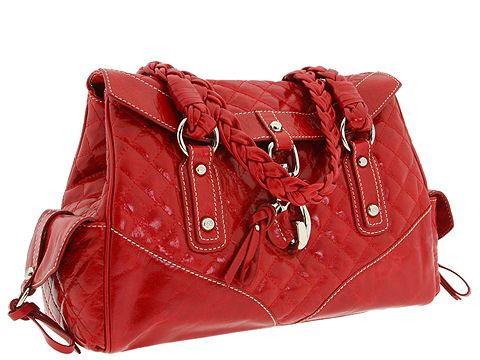 purse always looked in proportion to the woman carrying it rather than a purse with a woman attached. Purses were one items that was frequently a color and not black.
purse always looked in proportion to the woman carrying it rather than a purse with a woman attached. Purses were one items that was frequently a color and not black.